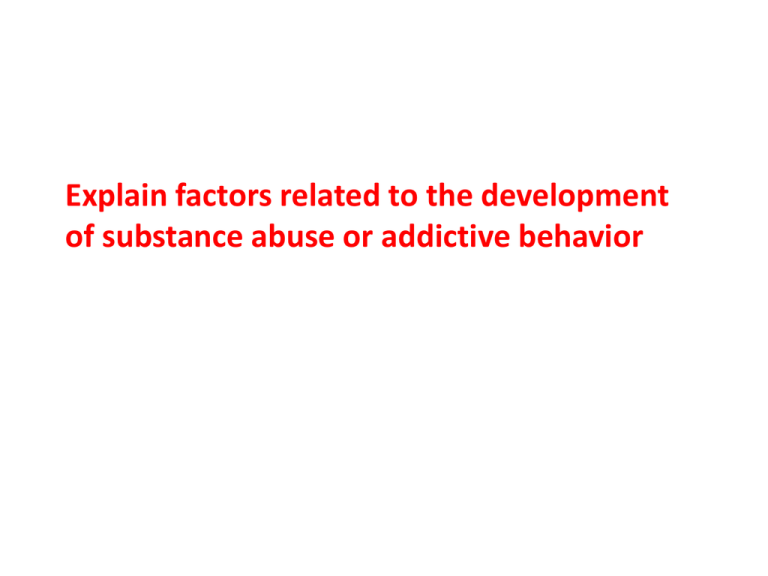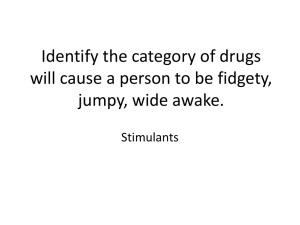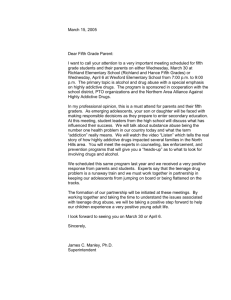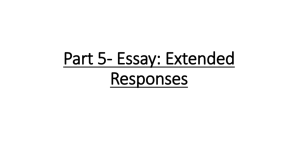Explain factors related to the development of substance abuse or
advertisement

Explain factors related to the development of substance abuse or addictive behavior Substance abuse • refers to the continued use of the substance despite knowing problems associated with the substance such as persistent desire to use it and/or unsuccessful efforts to control substance use. • Smoking could be an example of substance abuse when smokers want to quit but find they are unable to. Explain factors related to the development of substance abuse or addictive behavior Substance dependence • This is demonstrated in craving (i.e. a strong desire to get the substance or engage in a behavior) and in withdrawal symptoms (i.e. the unpleasant physiological and psychological symptoms when people don’t get the substance on which they are dependent). Explain factors related to the development of substance abuse or addictive behavior Addiction • (or addictive behavior) occurs when people become physically or biologically dependent on a substance because of repeated use over time. Explain factors related to the development of substance abuse or addictive behavior Smoking Explain factors related to the development of substance abuse or addictive behavior Biological factors of Smoking • The psychoactive drug in tobacco is nicotine. • Nicotine alters levels of neurotransmitters (e.g. acetylcholine, dopamine, adrenaline, vasopressin). • Secretion of adrenaline results in temporarily increased heart rate and blood pressure. • Secretion of dopamine is involved in the alteration of mood. • Secretion of acetylcholine appears to enhance memory. • Nicotine is also associated with relaxation and changes in mood. Explain factors related to the development of substance abuse or addictive behavior Biological factors of Smoking • Nicotine is a highly addictive substance. A habitual smoker will experience withdrawal symptoms if the level of nicotine is not constant in the body. • This could explain why up to 80% of smokers in the USA who would like to quit are not able to do it (Benowitz, 2009). Explain factors related to the development of substance abuse or addictive behavior Biological factors of Smoking • Marks et al. (2005) report that although teenagers’ initial reaction to tobacco smoke is generally negative, they quickly develop a taste for it. • Young smokers report that smoking has a calming effect and that they experience craving if they cannot smoke. • This is confirmed in measurement of nicotine levels in the saliva. Within a couple of years, teenagers report that they find it difficult to stop. Explain factors related to the development of substance abuse or addictive behavior Research on adolescents’ smoking history and addiction DiFranza et al. (2006) • The aim of the study was to investigate the relationship between attitudes to smoking and smoking habits. • The design was longitudinal and used questionnaires and interviews for data collection. In Massachusetts 217 adolescents (mean age 12) answered questionnaires on their smoking history, social environment (e.g. family and peers) as well as beliefs and attitudes towards smoking. • All participants reported having smoked a cigarette at least once. Explain factors related to the development of substance abuse or addictive behavior Research on adolescents’ smoking history and addiction DiFranza et al. (2006) • The results showed that of those adolescents who recalled a relaxation effect after their first inhale, 67% became dependent compared to 29% of those who did not experience such an effect. Explain factors related to the development of substance abuse or addictive behavior Research on adolescents’ smoking history and addiction DiFranza et al. (2006) • Feelings of relaxation after inhalation were the main risk factor for addiction. • Of the participants who the experienced relaxation effect, 91% reported that it was not possible for them to quit smoking even though they wanted to and 60% said they felt they had lost control. Explain factors related to the development of substance abuse or addictive behavior Research on adolescents’ smoking history and addiction DiFranza et al. (2006) • The conclusion was that for some people addiction to smoking seems to start almost after the first puff but it is unknown why some are more vulnerable to nicotine addiction than others. • It could be genetic but smoking is a complex behavior where both genes and environmental factors interact. Explain factors related to the development of substance abuse or addictive behavior Sociocultural factors of Smoking • According to social learning theory (SLT) smoking is learned through modeling (remember Bandura). • This could apply to the role of parents and peers in the initiation of smoking. Explain factors related to the development of substance abuse or addictive behavior Is it peer pressure (conformity…Asch)? Explain factors related to the development of substance abuse or addictive behavior Role of advertising and marketing in smoking • Consumer research shows that tobacco advertising has a powerful effect on smoking attitudes and behavior of young people. • The use of imagery and positive association in combination with brand consciousness in young people influences the young to smoke the most popular and welladvertised product. Explain factors related to the development of substance abuse or addictive behavior Role of advertising and marketing in smoking • Advertising functions as a “cue” to smoking (e.g. associating pleasure and fun with smoking may activate craving in smokers but it could also motivate young people to start smoking). • Tobacco sponsorships promote brand association and makes it easier to start smoking. Charlton et al. (1997) found that boys who showed a preference for Formula One motor racing that was sponsored by cigarette manufacturers were more likely to start smoking. Explain factors related to the development of substance abuse or addictive behavior







